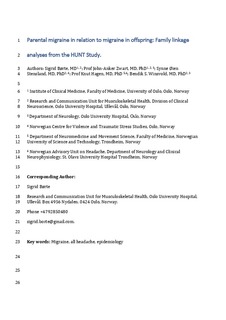| dc.contributor.author | Børte, Sigrid | |
| dc.contributor.author | Zwart, John-Anker | |
| dc.contributor.author | Stensland, Synne | |
| dc.contributor.author | Hagen, Knut | |
| dc.contributor.author | Winsvold, Bendik K S | |
| dc.date.accessioned | 2020-01-23T12:43:31Z | |
| dc.date.available | 2020-01-23T12:43:31Z | |
| dc.date.created | 2019-05-20T18:17:25Z | |
| dc.date.issued | 2019 | |
| dc.identifier.citation | Cephalalgia. 2019, 39 (7), 854-862. | nb_NO |
| dc.identifier.issn | 0333-1024 | |
| dc.identifier.uri | http://hdl.handle.net/11250/2637648 | |
| dc.description.abstract | Background
Migraine is known to run in families. While some clinical studies have indicated that migraine is disproportionally transmitted through the maternal line, this has not been examined in a population-based setting.
Methods
We utilized a large, population-based cohort study from Norway, the HUNT Study. Using a cross-sectional design, our sample consisted of 13,731 parents and 8970 offspring. Logistic regression was used to calculate odds ratios with 95% confidence intervals for active migraine and non-migrainous headache in offspring, given active maternal or paternal headache.
Results
There was a significant association between maternal migraine and offspring migraine (odds ratio 2.76, 95% confidence interval 2.18–3.51). A weaker association (p = 0.004 for comparison with maternal migraine) was found between paternal migraine and offspring migraine (odds ratio 1.67, 95% confidence interval 1.33–2.28). For non-migrainous headache, there was a significant association between mothers and offspring (odds ratio 1.25, 95% confidence interval 1.10–1.43), but not between fathers and offspring.
Conclusions
Parental migraine is associated with offspring migraine, with a stronger association for maternal migraine. This may indicate maternal-specific transmission. | nb_NO |
| dc.language.iso | eng | nb_NO |
| dc.publisher | SAGE Publications | nb_NO |
| dc.title | Parental migraine in relation to migraine in offspring: Family linkage analyses from the HUNT Study | nb_NO |
| dc.type | Journal article | nb_NO |
| dc.type | Peer reviewed | nb_NO |
| dc.description.version | acceptedVersion | nb_NO |
| dc.source.pagenumber | 854-862 | nb_NO |
| dc.source.volume | 39 | nb_NO |
| dc.source.journal | Cephalalgia | nb_NO |
| dc.source.issue | 7 | nb_NO |
| dc.identifier.doi | 10.1177/0333102419828989 | |
| dc.identifier.cristin | 1698914 | |
| dc.description.localcode | © 2019. This is the authors' accepted and refereed manuscript to the article. The final authenticated version is available online at: https://doi.org/10.1177%2F0333102419828989 | nb_NO |
| cristin.unitcode | 194,65,30,0 | |
| cristin.unitcode | 1920,16,1,0 | |
| cristin.unitcode | 1920,16,0,0 | |
| cristin.unitname | Institutt for nevromedisin og bevegelsesvitenskap | |
| cristin.unitname | Nasjonal kompetansetjeneste for hodepine | |
| cristin.unitname | Nevroklinikken | |
| cristin.ispublished | true | |
| cristin.fulltext | postprint | |
| cristin.qualitycode | 1 | |
